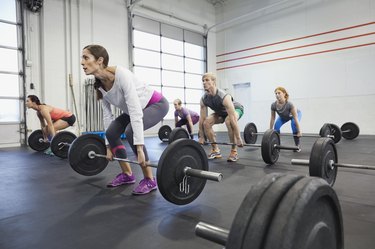
Doctors use the word vascularity in connection with the venous system, or veins. For bodybuilders, however, the word takes on a specific meaning concerning the visibility of your veins under your skin.
Ideally, they stand out in sharp relief against your muscles, giving your body a rugged, fit appearance. With good leg vascularity, the femoral and tibial veins — the main veins in your leg — are particularly well-defined.
Video of the Day
Video of the Day
Although the way in which your veins lie under your skin is influenced by genetics, specific techniques allow you to enhance and highlight your natural leg vascularity.
Training for Vascular Muscles
To have vascular, muscular legs, you must engage in a training program designed to build muscle, particularly in your quadriceps and calves. ACE Fitness recommends strength training with heavy weights at low repetitions to stimulate muscle fibers and increase vascularity.
Leg presses, leg extensions and seated and lying leg curls on a weight machine are examples of exercises to incorporate into your routine. One-legged squats — in which you squat with one leg extended straight out in front of you — are particularly effective for building leg muscle and are one of the more difficult exercises according to ExRx.
The Massachusetts Institute of Technology recommends that body builders stretch immediately after the "pump." During this phenomenon the weight lifter's muscles are shortened and the build up of lactic acid will cause soreness. Stretching will hasten the removal of lactic acid and even though the "pumped" muscle will appear smaller, the muscle itself will be ready for the next session.
Consult your doctor before beginning a new exercise regimen; a qualified trainer can suggest a workout tailored specifically to your needs.
Kicking Up Your Cardio
Boost the blood flow throughout your body by adding cardio to your game plan. Cardio exercise improves the capacity of your blood vessels to dilate, boosts the flow of oxygen to your muscles and improves vascularity by reducing water retention.
Add in moderate-intensity cardio exercise such as walking or light calisthenics for 150 to 300 minutes per week recommends the Physical Activity Guidelines for Americans. If you do more vigorous exercises — such as running, cycling 10 mph, boxing and swimming — aim for 20 to 60 minutes, three days a week, to give you similar benefits.
Eating for Results
Most bodybuilders eat a specialized diet to achieve the low body fat that is essential for vascularity. To keep muscle mass you need less than you think. The Academy of Nutrition and Dietetics advises consuming 0.37g of protein for every pound you weigh.
Avoid saturated fats in favor of polyunsaturated fats, found in flaxseed and fish oils, and monounsaturated fats, found in nuts and avocados. Drinking sufficient amounts of water can help increase vascularity. Check with your physician or a dietitian before embarking on a bodybuilding diet.
Read more: Can I Start Bodybuilding in My 30s?
Enhancing the Vascular Appearance
If you have progressed to bodybuilding exhibitions and contests, there are techniques you can use to enhance your leg vascularity before going onstage.
Boost vascularity by warming up immediately before the contest with light pumping, flexing, posing and exercises, including calf raises and squats. Or you can use more unconventional methods, according to WorkoutHQ, like eating spicy foods or hot peppers, using a sauna or blowing your skin with a hair dryer —a temporary solution and potentially painful. So use with caution.
- WorkoutHQ.org: "How to Make Veins Pop"
- ACE Fitness: "How Many Reps Should You Be Doing?"
- ExRx.net: "Single Leg Squat (Pistol)"
- Health.gov: “Physical Activity Guidelines for Americans”
- Academy of Nutrition and Dietetics: "4 Keys to Strength Building and Muscle Mass"
- Massachusetts Institute of Technology: "Why Bodybuilders Should Stretch"
- Get Body Smart: Major Systemic Veins